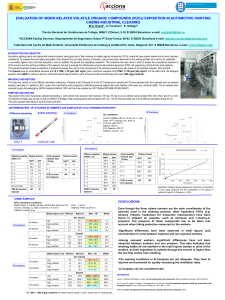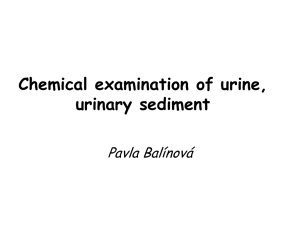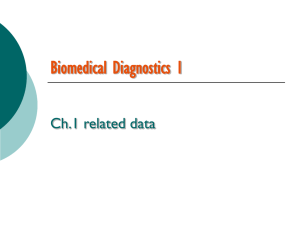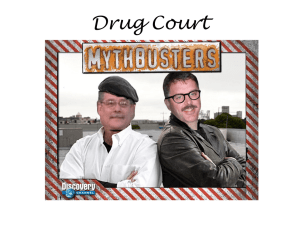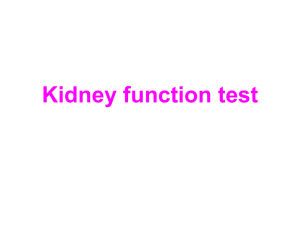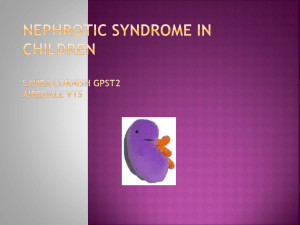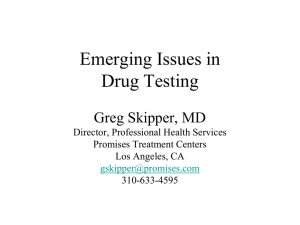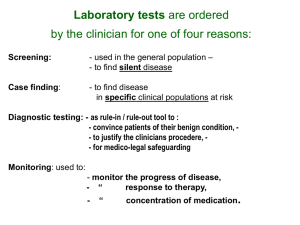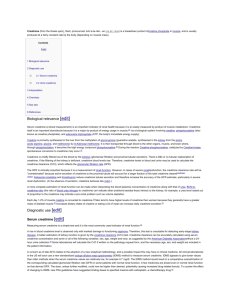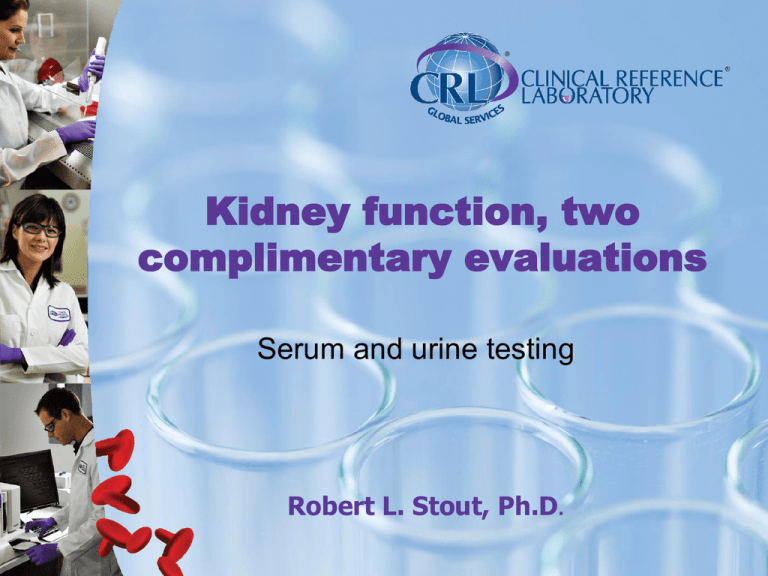
Kidney function, two
complimentary evaluations
Serum and urine testing
Robert L. Stout, Ph.D.
Tests of kidney function
•
•
•
•
Measured glomerular filtration rate.
Urinalysis
Serum creatinine and blood urea nitrogen.
Estimated glomerular filtration rate, eGFR.
Measured glomerular
filtration rate
• Only on patients with known kidney
disease to determine severity.
• Requires injection of a tag; radioactive,
non-metabolizable sugar or dye.
• Collect samples and determine clearance
rate.
Urine protein and urine
creatinine
• The kidneys filter the blood to remove
metabolites, waste material(s), salts, and
water.
• The kidneys also recover water, glucose,
salts and amino acids from the forming urine.
• This process concentrates the urine while
recovering important building material for the
body.
Proteinuria
• The kidneys loose about 100-150mg of
protein per day.
• On average about 1.0 to 1.5 gram of
creatinine is produced per day depending
on your muscle mass.
• Depending on your hydration state most
people produce about 1 to 1.5 liters of
urine per day.
Protein creatinine ratio
• It is both inconvenient and impractical to collect
all the urine produced during a day.
• Urine concentration varies widely depending
on the hydration state.
• The urine protein creatinine ratio allows an
accurate measure of the average protein loss
per day and is reported by all laboratories.
Fulks M, Stout RL, Dolan VF. Urine
Protein/Creatinine Ratio as a Mortality Risk
Predictor in Non-Diabetics with Normal Renal
Function. J. Insurance Medicine. 2012;43:76-83
Serum creatinine a measure of
renal function
• Serum creatinine values are the result of 2
opposing factors
– Production is driven by muscle mass; men
have higher creatinine values than women of
the same age.
– Elimination is driven by filtration in the
kidneys; as we age the kidneys have
decreased capacity for filtration.
Aging and serum creatinine
• Normal aging is accompanied by a decrease
in muscle mass.
• Normal aging is also accompanied by a
decrease in kidney filtration and elimination of
creatinine.
• Insurance product pricing accounts for the
increasing mortality associated with normal
aging.
• Underwriters need an objective measure of
“age based normal renal function”.
Sex, age and mean serum
creatinine
Upper range of expected value
for creatinine
The samples
• A blood sample and urine may be
collected anytime that is convenient for an
applicant and paramedical examiner.
• The serum sample is allowed to clot and
then centrifuged to separate the liquid
portion (serum) from the clot, trapped cells
and fibrin.
Things that can go wrong.
• For the urine, the only big problem is
sample mix-up.
• In contrast, if the serum sample is not
centrifuged within 2 hours there is a
risk for,
– Glycolysis, the catabolism of glucose in
the sample
– Hemolysis, the rupture of red cells and
release of hemoglobin into the serum.
Hemolysis and glycolysis
• How do these effect the serum creatinine
value?
• Which is the best indicator that something
has gone wrong?
• If there was a problem can the underwriter
still reliably proceed with the review?
Serum glucose (glycolysis) and
creatinine
Glycolysis
Hemolysis and serum
creatinine
Serum creatinine set at
1.45mg/dL
GLUCOSE
<= 10
Glycolysis
11-20
21 - 30
31 - 40
41 - 50
51 - 60
Total
61 - 70 71+
<= 1.45
82.19%
93.90%
96.75%
97.56%
98.59%
98.88%
99.16% 99.09%
224584
1.46+
17.81%
6.10%
3.25%
2.44%
1.41%
1.12%
0.84%
0.91%
4849
% high
1.04%
0.12%
0.07%
0.07%
0.05%
0.06%
0.09%
0.62%
2.11%
% total
5.80%
2.00%
2.20%
2.80%
3.70%
5.50%
10.20% 67.80%
229433
Serum
Creatinine
Serum creatinine set at
1.45mg/dL
GLUCOSE
<= 10
Serum
Creat
Glycolysis
11-20
21 - 30
31 - 40
41 - 50
51 - 60
61 - 70
Total
71+
82.19%
93.90%
96.75%
97.56%
98.59%
98.88%
99.16% 99.09%
224584
17.81%
6.10%
3.25%
2.44%
1.41%
1.12%
0.84%
0.91%
4849
1.04%
0.12%
0.07%
0.07%
0.05%
0.06%
0.09%
0.62%
2.11%
5.80%
2.00%
2.20%
2.80%
3.70%
5.50%
10.20% 67.80%
<= 1.45
1.46+
% high
% TOTAL
229433
Enzymatic and Jaffe
creatinine
Jaffe serum creatinine>1.5
evaluated by 2 methods
Estimated glomerular
filtration rate
• Half a dozen different equations.
– The Mayo equation (Rule) and the CKDEPI equations are the most common.
• They both work, however, they do
not have the same mortality risk
ranges.
– If you use the tables from reinsurance
most use the Mayo.
National Kidney Disease Education Program 2014
Be wary of Trojan horses
• In the insurance industry all current
assessments of kidney function rely on a
serum creatinine.
• Jaffe serum creatinine results in samples
with low glucose values are not reliable.
You can directly substitute an enzymatic
creatinine into the eGFR calculation.
Case study
• Female 62yo, non-smoker, chemistry all
normal except glucose is 0 and creatinine
is 1.4mg/dL.
– eGFR = 38 ml/min/1.73m2
• Enzymatic creatinine was 0.9mg/dL
– eGFR=69 ml/min/1.73m2
Case study
• Male 62yo, 6’4”, 340lb, all normal except
glucose is 0 and creatinine is 1.4mg/dL,
urine 0.25pro/creatinine
• Enzymatic creatinine was 1.4mg/dL
– Both eGFR is 51ml/min/1.73m2
– Corrected for body surface area 71ml/min
• 25% of applicants with proteinuria have
normal eGFR
Questions?????



